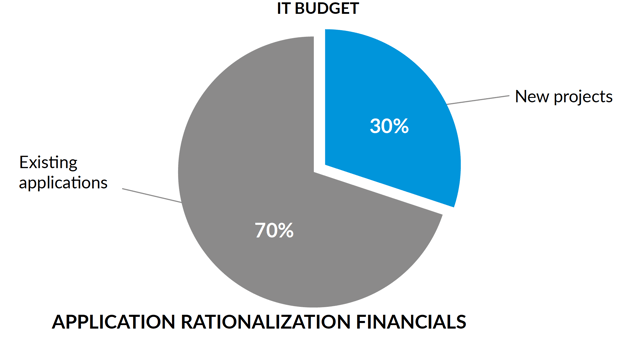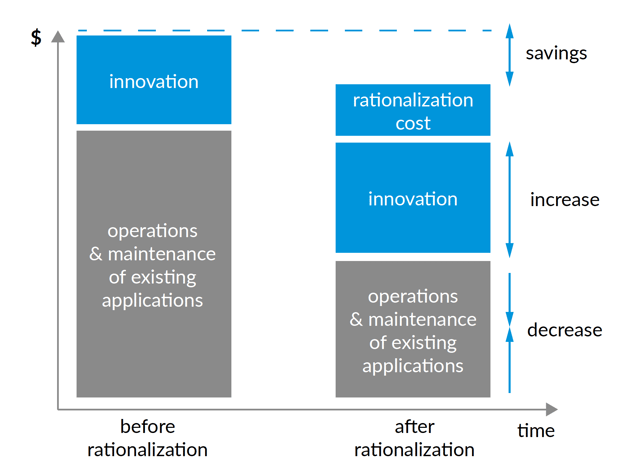
In today’s world, businesses with an agile IT landscape are better prepared for the inevitable changes that digital transformation creates. To keep up with the rapidly accelerating pace of business, enterprises have amassed thousands of applications in their portfolios as a result of various drivers, including strategic mergers and acquisitions, organizational changes, hardware upgrades, and the adaption of cutting-edge technology.
As a result, their IT environments become incredibly rigid, complex, and expensive to maintain. The environment also produces silos of redundant information, which negatively affects the bottom line. LeanIX internal research indicates that large enterprises (> €1 billion annual revenues) have an average of 650 applications deployed. The 10% largest companies even have an average of a staggering 3400.
Not all of these applications are mission critical. To stay abreast of current innovative trends, provide first-class customer service, reduce cost, and scale globally, enterprises benefit from having a tightly rationalized application landscape.
Primarily focused on driving fiscal growth, the business side requires a quick paced business - often times overlooking the need to continuously align the supporting IT landscape. Consequently, various applications are introduced at different points of time with overlapping functionality, different lifecycles, and technologies, which often results in major integration issues and various business-wide inefficiencies. Running a complex, rigid IT ecosystem increases IT spend by hundreds of millions of dollars, while directly decreasing the quality of service and satisfaction of those who rely on it.
As IT cost optimization is a high priority for CIOs, application rationalization should be regarded as an efficient cost saving endeavor. According to a recent study by Capgemini, 48% of CIOs believe that there are more applications in their portfolio than the business actually requires.
TO RATIONALIZE OR NOT TO RATIONALIZE
What is Application Rationalization?
Application portfolio rationalization is the act of streamlining the existing application portfolio with an explicit goal of improving efficiency, reducing complexity, and lowering total cost of ownership (TCO) through a myriad of processes.
Application rationalization sets the basis for other cost-saving endeavors, including:
- Software license optimization
- Application retirement
- Server optimization
- Project rationalization
- Data storage optimization
- Retiring aged and low-value applications
- Eliminating redundancies
- Standardizing common technology platforms.
Application rationalization, or active application portfolio management, is crucial to the overall health of the company, as there will always be a future event that calls for adjusting the application landscape.
Various naturally occurring business events directly contribute to IT landscape complexity, including mergers & acquisitions, global outsourcing, rapid growth, and the introduction of new business goals or processes.
Why rationalize? The key benefits of application rationalization
Application rationalization is an effective way to identify capital for reinvestment. Infosys reports that application rationalization can lead to the cost-saving of more than US $2 million in a single enterprise. Currently, 75-80% of IT budgets are spent on operating and managing applications. Research shows that over 70% of corporate data still lies in legacy systems. In our rapidly evolving IT environment, IT leaders are under pressure to integrate new technologies that improve overall efficiency including cloud computing, machine learning, artificial intelligence and big data. Integrating these potentially beneficial technologies take a considerable amount of time, energy, and focus - resources that are currently dedicated to maintaining existing complex systems.
Application rationalization also helps organizations streamline processes, reduce maintenance cost, enhance overall quality and efficiency, lower total cost of ownership (TCO), ensure compliance, and increase agility. It also frees up the time, money, and personnel to research and implement profit generating innovations. Without active application portfolio management, organizations run the risk of application sprawl. Application sprawl is the unmanageable growth of an IT portfolio. IT portfolios that experience application sprawl suffer from inefficiency due to poor design, lethargy, redundancies, and over exhausted resources. This could directly impede an organization’s ability to stay competitive and innovative.
This white paper explains in detail how an Enterprise Architecture approach to application rationalization can help contribute to the bottom line.
MAKING THE BUSINESS CASE FOR APPLICATION RATIONALIZATION
Many CEOs and CFOs see the IT budget as an area of overspend and are constantly looking for ways to reduce expenses. Currently, IT spend makes up 1-5% of an enterprise’s overall budget. It is possible to reduce costs by 15% by eliminating redundant applications without affecting quality and business value. A study conducted by Cast Software revealed that the average code base carries approximately US $1,055,000 of technical debt.
While application rationalization endeavors require an initial investment, it results in immense savings. Consolidating similar applications and reducing redundant data can significantly change an organization’s cost structure by creating an environment for reducing excessive expenditure including maintenance and operational cost, see figures 1 and 2 below.

Figure 1: A typical split of IT budget

Figure 2: The financial mechanics of application rationalization
The key levers to save
When initiating application rationalization projects, many Enterprise Architects will be asked to present a business case or an exhaustive estimate of potential cost savings. The following categories help to structure such an analysis.
Rationalize software licenses
A mass of licenses can carry unused, idle, and inessential applications currently in use. When rationalizing software licenses, CIOs, Enterprise Architects should join together and determine how many licenses are actually required to achieve business goals and which should be decommissioned. Once there is transparency on software licenses, EAs/CIOs will have a roadmap to consolidate vendors and eventually negotiate discounts.
Medium and large enterprise software customers manage upwards of 70 software license contracts, which require renegotiation and renewal at various times throughout a year. Simply put, with fewer applications, you pay fewer license costs. Gaining control of your software estate drives 5-30% savings in annual software spend and continuous license compliance.
Decommission little-used or redundant applications
70% of CIOs believe that at least one-fifth of their applications could be consolidated by eliminating redundant functionality. Applications that are seldom used, never used, or overlooked, cost organizations millions each year. Larger enterprises often have duplicate applications with intricate custom-built add-ons that mimic similar functions. An application rationalization program can uncover these costly redundancies, and from there, organizations can reduce IT spend by tens or hundreds of millions of dollars.
For example: During an application rationalization project, a large engineering company uncovered that a single sales team was using an unsupported version of a retired CRM system to produce a single report. This usage of an unsupported application exposed the company to additional data risk and cost the company close to USD $1.5 million each year. While reviewing an application matrix report with risks highlighted, business leaders could plainly see which applications were of low value and barely used. The company decided to retire this CRM instance and to select one global standard CRM application for all user groups across the company.
Less compliance/governance cost
With impending regulations on the rise, organizations must be aware of the level of compliance in their application portfolio. Application rationalization allows the organization to analyze their portfolio landscape, facilitate transparency, and survey applications to choose the best fit application.
For example: Under the European Union General Data Protection Regulation (EU GDPR), your organization will need to understand how you obtain, transfer, store and handle data. If an application that you are running collects the personally identifiable information (PII) of your customers, and your IT leaders do not know where the data is stored, how to access it, or how to manipulate it, then this application would be non-compliant under the EU GDPR. Noncompliance with the EU GDPR will put your organization at grave risks of fines and penalties. Proposed penalties will reach an upper limit of €20 million or 4% or annual global turnover – whichever is higher.
Infrastructure and data center consolidation
Operating fewer applications results in less money spent on servers, cloud space, and supporting maintenance cost. Infrastructure and data center consolidation are essential components of a successful application rationalization venture.
For example: After an application rationalization program, a real estate services firm presented the TCO of each application to the prospective application owners. After viewing the staggering figures, the application owners agreed to retire 120 applications. In addition to reducing complexity, the company avoided USD $1.4 million in annual server and storage expenses by repurposing assets instead of buying new ones.
Reduced maintenance & training cost
Every deployed application requires some amount of support from vendors or in-house employees. If there are fewer applications to support, there will be less money spent on maintenance. Freeing up resources from supporting a heavy application landscape will also enable businesses to reinvest resources in innovative projects.
Project rationalization
Managing a handful of complex projects at the same time can prove to be confusing, and can muddle the application landscape.
With application rationalization, teams can categorize projects in the following organizational groups:
- Projects that have high business value and directly support the IT strategy,
- Projects that have high business value but don’t directly comply with the IT strategy and should be slightly reshaped,
- Projects that comply with the IT strategy but have little business value and should be delayed,
- Projects that have low business value and no IT relevance which should be abandoned.
From this classification, it will be easy to identify opportunities where applications can be decommissioned, vendors can be consolidated, and low-value projects can be canceled.
Vendor consolidation
Vendor consolidation is a powerful and cost-effective outcome of application rationalization. Consolidating your application providers to a just handful of vendors gives you the leverage to negotiate for better pricing, cuts back on time spent on paperwork with numerous vendors, and directly increases your buying power. A global study by the Everest Research Institute reports that having fewer suppliers lowers TCO by 22-28% annually. Gartner reports that many organizations can cut spending on software by as much as 30% by implementing software license optimization best practices.
Application rationalization also helps with…
Next to the hard savings, application rationalization pays off in many other situations. Many of them are not easy to quantify in a general way, but they can help to additionally motivate for application rationalization.
- Mergers & acquisitions. Application rationalization performed before, during, and after M&As helps to assess the best strategic fit for combining applications from the two separate organizations.
- Vendor management. Once business leaders have a full view of their application landscape, they can negotiate wisely with vendors. By having a detailed application inventory, it is possible to, e.g., negotiate the license price or service level agreements.
- Business process management. Rationalizing applications will uncover gaps or data redundancies which slow down business process. By sorting out these redundancies, companies can focus on bringing innovation to the organization and the end user.
- Outsourcing. It is crucial to have a comprehensive overview of which application assets are beneficial, and which are carrying dead weight before moving operations. Organizations will also be able to tell which services are necessary to require before signing any agreements.
- Audit management. During an audit, it is possible to discover which aspects of the business carries the highest risk and to address them accordingly.
Stay tuned for the second installment, which will include the complete guide to application rationalization.
![How Application Rationalization Contributes to the Bottom Line - and a Guide to Do it [White Paper]:Learn everything you need to know about application portfolio management (APM), including best practices, how to get started with APM and a complete guide on application portfolio management. »](https://no-cache.hubspot.com/cta/default/2570476/7208ee2f-46f1-4fa0-a0dd-9a43dbfef8ce.png)
![The Cost of Self-Made Enterprise Architecture [White Paper]: Find out what benefits an enterprise architecture management tool has vs excel, powerpoint and visio.. »](https://no-cache.hubspot.com/cta/default/2570476/4b56f35b-03d5-482c-94d2-9af5ed76ab6b.png)

/EN/White-Paper/EN-IDC-Inforbrief-Application-Rationalization-Portfolio-Management-Thumbnail_v2.png?width=140&height=99&name=EN-IDC-Inforbrief-Application-Rationalization-Portfolio-Management-Thumbnail_v2.png)
/EN/White-Paper/Newsletter-Thumbnail%20IDC%20Final.png?width=140&height=100&name=Newsletter-Thumbnail%20IDC%20Final.png)
/EN/Reports/Thumbnail-Gartner%20720x500.png?width=140&height=100&name=Thumbnail-Gartner%20720x500.png)
